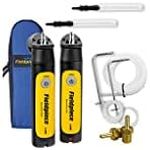Buying Guide for the Best manometers
Choosing the right manometer is all about understanding what you need to measure and in what environment. Manometers are devices used to measure pressure, often of gases or liquids, and are commonly used in HVAC, laboratory, and industrial settings. Before buying, think about the type of pressure you need to measure, the range of pressures, the environment where you'll use the device, and how you want to read the results. Knowing these factors will help you select a manometer that is accurate, reliable, and easy to use for your specific application.Type (Analog vs. Digital)The type of manometer refers to whether it is analog (like a U-tube or inclined manometer) or digital. Analog manometers use liquid columns or mechanical parts to show pressure, while digital manometers use electronic sensors and display the reading on a screen. Analog types are simple, durable, and don’t need batteries, but can be harder to read and less precise. Digital manometers are easier to read, often more accurate, and can have extra features like data logging, but they require batteries and can be more sensitive to rough handling. Choose analog if you want simplicity and ruggedness, or digital if you need precision and convenience.
Pressure RangePressure range is the span of pressures the manometer can measure, usually given in units like psi, Pa, or mmHg. It’s important because using a manometer outside its range can damage it or give inaccurate readings. Low-range manometers are best for small pressure differences, like in HVAC or laboratory work, while high-range models are needed for industrial or process applications. Pick a manometer with a range that covers your typical measurements, but not so wide that you lose accuracy at the low end.
AccuracyAccuracy tells you how close the manometer’s reading is to the actual pressure. It’s usually given as a percentage of the full scale. Higher accuracy is important for scientific or calibration work, while lower accuracy may be fine for general monitoring. If your work requires precise measurements, look for a manometer with a low percentage error. For less critical tasks, a standard accuracy will suffice.
ResolutionResolution is the smallest change in pressure the manometer can detect and display. Higher resolution means you can see smaller changes, which is important for fine adjustments or sensitive measurements. For general use, standard resolution is enough, but for laboratory or calibration work, higher resolution is better.
Units of MeasurementManometers can display pressure in different units, such as psi, Pa, bar, or mmHg. Some digital models let you switch between units. It’s important to choose a manometer that uses the units you’re familiar with or that match your application, so you don’t have to convert values or risk mistakes.
Portability and DurabilityPortability refers to how easy it is to carry and use the manometer in different locations, while durability is about how well it stands up to drops, dust, or moisture. If you need to move the manometer around a lot or use it in tough environments, look for a compact, rugged model with protective features. For stationary or clean environments, these features are less critical.
Additional FeaturesSome manometers come with extra features like data logging, backlit displays, Bluetooth connectivity, or the ability to measure temperature as well. These can make your work easier or more efficient, especially if you need to keep records or work in low-light conditions. Think about which features would actually help you, and don’t pay extra for things you won’t use.



















